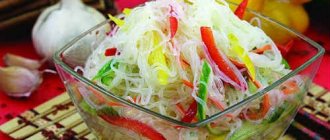Dishes using soy sauce
Soy sauce has a dark brown (almost black) color and a distinct sweet and sour taste.
Depending on the manufacturer and brand, it may have a different flavor. Soy sauce is produced by fermenting soybeans. Soy sauce recipes with photos can be found very easily. You can cook anything yourself with the addition of this ingredient if you follow the recipe. Soy sauce goes great with rice. Many people know that it is better to eat sushi or rolls with it, then they will not only be salty, but also tasty. There are other dishes with soy sauce. You can add it to a meat or fish dish during the cooking process or after it is cooked.
There are about a dozen varieties of soy sauce. They differ from each other in taste, smell, color, composition, consistency. Also, the salt content in it varies. This sauce is often used in Asian cuisine, but it is also used very extensively in others. When choosing a sauce, you should consider its composition. If the packaging says a lot of preservatives of group “E”, then you should abandon this choice and find a quality product.
Beef in soy sauce
Below is a step-by-step recipe according to which the beef is cooked in half an hour, but always turns out soft and melts in your mouth. Due to the short cooking time, the meat retains all the beneficial substances.
To prepare you will need:
beef – 1 kg; garlic – 4 teeth; white onion – 2 pcs.; soy sauce – 200 ml; red hot pepper - to taste.
Cooking process:
Cut the beef into thin strips. Make sure that the cut runs along the grain.
The thinner the pieces, the faster the dish will cook. Place the beef in a deep bowl and pour soy sauce over it. Leave to marinate in a cool place for 4 – 5 hours. Or better yet, for the whole night. Cut the onion into cubes and fry until transparent. For a spicier dish, you can add finely chopped spicy pod at this stage. Add the beef to the onions and peppers, mix and simmer over high heat for 20 - 25 minutes, stirring occasionally. If necessary, add water. Simmer for another 15 - 20 minutes, after which the beef in soy sauce will be ready.
Delicious dishes with soy sauce
Soy sauce is used in the process of marinating meat, fish and poultry. You can pour soy sauce over the chopped pork, add pepper and onion rings. Then leave the meat in the refrigerator for several hours, and then fry excellent kebabs in nature. Dishes containing soy sauce usually do not need additional salt. The sauce itself already contains the required amount of salt. But, if the sauce is bland, then it will be necessary to add salt to the dish during cooking.
To prepare a delicious dish, you should choose a high-quality sauce, since a low-quality product can ruin it. It is better to buy this product in specialized Japanese or Chinese online stores. But this is not always possible, so housewives go to a regular supermarket. Simple soy sauce dishes can turn out delicious if the sauce itself is of the right quality.
When choosing soy sauce in a store, you should pay attention to what is written on its packaging. The bottle itself should be transparent. It can be glass or plastic. The liquid in it is dark in color and without sediment. Soy sauce should be made by naturally fermenting the beans rather than by chemical processing. Ingredients: soybean mixture, water, salt. Inexpensive products contain preservatives and flavor enhancers.
Pork recipe
Below is a good option for a dish that can diversify a boring home menu. The meat turns out moderately juicy and fatty. Soy sauce gives it sophistication and subtle taste.
For cooking you will need:
pork (preferably neck) – 1 kg; dried seasonings - 1 tsp; soy sauce – 200 ml; sesame – 2.5 tsp; white onion – 4 pcs.; vegetable oil (for frying); garlic – 7 – 8 teeth; water – half a glass; starch – 1.5 tsp.
Step by step process:
Wash and dry the meat with paper towels, cut into small pieces.
Place the pork in a deep bowl and pour in soy sauce. Stir and leave to marinate in the refrigerator for half an hour. We do not cut the onion into thin rings, but the garlic, on the contrary, into thin slices. It is not recommended to crush or grate it. Heat vegetable oil in a hot frying pan. Place the pork in it and pour in the marinade in which it was soaked. Cook for 6 – 7 minutes covered. Turn the meat periodically. Add onion and garlic. Simmer for another 6 minutes. Add starch to a glass of water and stir. Pour water into the pan, add sesame seeds and herbs. Mix the mixture thoroughly and simmer the meat for about half an hour over low heat. Pork in soy sauce will be ready as soon as all the liquid is absorbed and the meat becomes soft and juicy.
Traditional Squid Heh
Recipe for lovers of Korean cuisine and squid.
For it you will need:
squid – 600 g; soy sauce – 8 tbsp. l.; carrots – 2 pcs.; ground pepper (can be red) – 2 s. l.; onions – 2 pcs.; salt – 1 tsp; vegetable oil – 4 tbsp. l.
Cooking process:
Clean the squid carcasses and place them in a deep pan. Cover completely with water and bring to a boil. Cook for exactly 3 minutes. Cool the boiled squid and cut into medium strips. Three carrots on a “Korean” grater, sprinkle with salt and leave for half an hour. Then squeeze out the juice released from the vegetable. Cut the onion into rings and fry in a frying pan, stirring from time to time. Mix all prepared ingredients, season with soy sauce and pepper. Leave in the refrigerator for half a day.
Choosing soy sauce
Soy sauce is the #1 seasoning in Asian cuisine. In any restaurant in Korea, China, Japan, Vietnam, Malaysia, Indonesia, Thailand and other Asian countries, there will always be soy sauce on the table, just like we have a salt and pepper shaker. This sauce can be used to season almost any Asian dish, from appetizers to soups. The composition of soy sauce is very simple - it is made from soybeans with the addition of salt and water. But if everything is so simple, the question arises - how to understand all the variety of soy sauces presented in the assortment of our store? In this review, we will tell you how soy sauces from Asian countries differ and how to make the right choice.
Naturally Prepared Soy Sauces vs. Hydrolyzed Sauces
Surely you have heard a lot about the technology of making soy sauce. Traditional technology involves fermentation of soybeans. This process takes months. Every self-respecting food company in Asia chooses the natural way to produce soy sauce. The reputation of a company, especially one working for export, is crucial. Therefore, you can safely choose soy sauces from large, famous brands - just don’t forget to read the ingredients on the label. In addition to soybeans, the composition may contain wheat.
Cheap soy sauces, prepared not naturally, but chemically (from soy protein hydrolyzed with acids), are immediately recognized by a connoisseur (and even just an amateur). They have a tart smell, a pungent taste and a not very pleasant aftertaste. Such sauces are produced in just a few days, they have a very low cost, and besides, such sauces contain carcinogens that, if consumed regularly, can cause cancer. Naturally prepared soy sauce is not such an expensive product to save on.
Thanks to the fermentation process of soybeans, naturally prepared soy sauce naturally forms a salt of glutamic acid - monosodium glutamate, which gives the sauce an umami taste - a mild, pleasant taste and a long aftertaste. Umami has the property of making the taste of a dish to which soy sauce is added more vibrant. Don't be afraid of monosodium glutamate. Naturally formed, natural monosodium glutamate is found in tomatoes, broccoli, many other vegetables, mushrooms, dairy products, and meat. Glutamic acid (an amino acid that is part of the proteins of all living organisms) is present in all foods that contain protein.
Thus, naturally prepared soy sauce has a delicate, noble, appetizing aroma, a pleasant salty taste and a wonderful aftertaste.
So, the first thing to take into account when choosing soy sauce is its natural origin. By the way, even famous soy sauce manufacturers have in their assortment sauces made from a mixture of natural and hydrolyzed ones. Such soy sauces are more affordable, and their taste is well balanced. Even in Japan, which is famous for its excellent quality products, they produce such sauces, and they are in great demand.
Next we will answer the question why we choose soy sauce. There can be two options.
The first is for use as a dipping sauce and seasoning, for example, for kimbap, rolls, sushi, meat, for dressing salads, adding to a bowl of broth, noodle soup, for flavoring freshly baked fish, and so on.
The second is for use as a seasoning in the preparation of Asian dishes.
Soy sauce as a seasoning for a finished dish
If you're choosing soy sauce to use as a dipping sauce or condiment, the easiest place to go is the kitchen. If you dip Korean kimbap rolls in sauce, then look for Korean-made sauces. If you need soy sauce for dipping rolls, sashimi and sushi in it, then choose from Japanese sauces. If you like Thai, Chinese, or Vietnamese cuisine, then we choose from the producers of these countries accordingly. In our “Soy sauces” section on the website you can filter them by country of production. Korean, Japanese, Chinese, Thai, and Vietnamese soy sauces differ in color, taste, salt level, consistency and aroma.
Korean sauces for dipping and flavoring prepared dishes are called Jin Gunjang. They are sweetish, with a low level of salt, and have a mild, pleasant taste. You can start getting acquainted with Korean soy sauces Jin with Singsong and Obok sauces, prepared using the natural fermentation method. They can be used as a dip sauce for meat, fish, vegetables, rolls, and for dressing salads. An excellent soy sauce is the Sempio brand, which is very popular in Korea. Sempio soy sauces are positioned by the manufacturer as premium quality sauces, and the raw materials for the sauces have been fermented for decades. “Golden” soy sauce from the respected large Korean brand Ottogi is a tasty sauce with a pleasant aftertaste, also suitable for dipping. Its price category is slightly lower, due to the fact that it is a mixture of naturally prepared and hydrolyzed sauces. Korean Sauces Gin is the best choice for introducing soy sauces as dipping sauces.
Japanese soy sauces contain, in addition to soybeans, also wheat (often in a 1:1 ratio), and this differs from their Chinese, Korean and other counterparts. It is difficult to single out any individual brands of Japanese soy sauces - the products of each of them are tasty in their own way, and the quality is traditionally high. When choosing, it is better to focus on your own taste, as well as the composition of the product. Japanese sauces have a rich dark color, their salt level is higher than that of Korean and Chinese, and due to the presence of wheat, Japanese soy sauces have a characteristic sweetish tint. Koikuchi soy sauces are used for dipping. True, Koikuti is a universal seasoning; this sauce is also used for cooking. Almost all Japanese soy sauces (and especially those exported to other countries) are Koikuchi. Other less common sauces include Usukuchi (even saltier because it uses fermented rice) and Tamari (a wheat-free sauce popular among gluten-intolerant Japanese), but these types of soy sauces are rarely found outside of Japan. .
Separately, it is worth mentioning the choice of soy sauce for dipping Japanese rolls, sushi and sashimi in it. Did you know that in Japanese restaurants the dipping seasoning they serve you is not soy sauce? This seasoning is made from a mixture of soy sauce and mirin, a sweet Japanese cooking wine. If you are preparing homemade rolls and dipping sauce for them, mix Japanese soy sauce with mirin in a 1:1 ratio, or adjust the proportions to your taste.
As for Chinese soy sauces, they have a bright, rich taste, and their salt level is lower than that of Japanese ones. For dipping, always choose light soy sauce - this is a classic, traditional Chinese soy sauce. There is also dark (dark), but it is used only when preparing dishes (stewing, frying), it is lightly salted, the taste is almost not expressed, its main purpose is to give a deep, rich dark color to the prepared dish.
There are so-called flavored varieties of Chinese soy sauces - for example, seafood sauce, which contains powdered dried scallops and white wine. There are sauces to which garlic, or pepper, or shrimp powder, or spices are added. There is also mushroom soy sauce - with dried tsaogu mushrooms crushed into powder, it enriches stewed meat and vegetable dishes, and vegetarians use it as a substitute for oyster sauce when preparing Asian dishes.
Soy sauce as a seasoning for cooking
Korean sauces used in cooking are called Guk Ganjang. They differ from Gin sauces in their richer taste and aroma, perfectly flavor and improve the taste of the dish, even a small dosage is enough for a large volume of ingredients. At the same time, the addition of Guk soy sauces does not affect the color of the dish. Our assortment includes a large selection of Korean soy sauces Guk - for soups, for stews and fish, for frying, for guksu, for poultry and many others.
When preparing Japanese dishes, the soy sauce almost always means universal Koikuchi sauce - we have already described it in detail above. As for Chinese cuisine, Chinese recipes may require the use of both light and dark soy sauces. If a Chinese recipe (or the name of the sauce itself) does not indicate the type of soy sauce, then it is light soy sauce by default. Dark soy sauce is necessarily labeled accordingly, and is specifically mentioned in the recipe. An excessive amount of dark soy sauce can ruin the color and taste of the dish, so we recommend strictly following the dosage indicated in the recipe.










